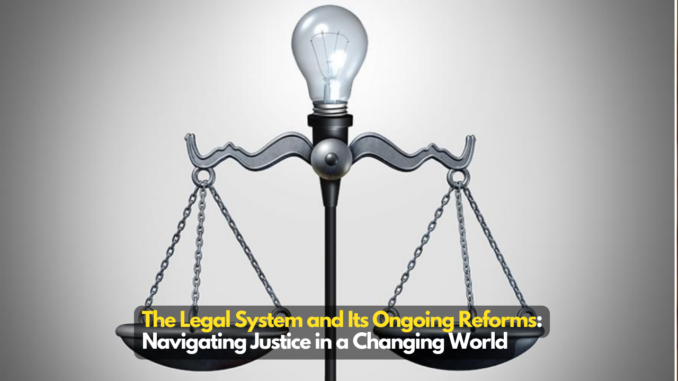
The legal system is the cornerstone of any society, serving as the framework that regulates behavior, resolves disputes, and upholds justice. However, as societies evolve, so do the complexities and challenges that the legal system must address. This has led to a continuous process of legal reform, where policymakers and legal scholars seek to adapt the system to better serve the changing needs of the people. In this discourse, we delve into the intricacies of the legal system, explore the rationales for ongoing reforms, and discuss some key areas where reform efforts have been particularly pronounced.
I. The Legal System: Foundation and Function: The legal system encompasses a network of laws, regulations, courts, and legal institutions that work together to maintain order, protect rights, and ensure fairness. It is grounded in principles of justice, equity, and due process, with the objective of creating a society where individuals can coexist harmoniously and have their disputes resolved fairly. The legal system’s primary functions include establishing norms, enforcing laws, adjudicating disputes, and protecting individual rights.
II. Reasons for Legal Reform: A. Adapting to Technological Advances: The rapid advancement of technology has introduced new challenges that traditional legal systems often struggle to address. Issues such as cybercrime, data privacy, and intellectual property rights have necessitated legal reform to ensure that the law remains relevant in the digital age.
B. Addressing Societal Changes: Social, cultural, and demographic shifts can render existing laws obsolete or inadequate. Legal systems must evolve to accommodate changing norms and values, such as those related to gender equality, LGBTQ+ rights, and environmental protection.
C. Enhancing Access to Justice: One of the central tenets of legal reform is improving access to justice for all citizens. Reforms aim to make legal processes more understandable, affordable, and accessible, especially for marginalized and disadvantaged communities.
D. Streamlining Complex Procedures: Over time, legal procedures can become convoluted and time-consuming. Reform efforts often focus on simplifying these procedures, reducing bureaucratic hurdles, and expediting the resolution of cases.
E. Ensuring Fairness and Minimizing Bias: Legal systems strive for impartiality, but biases can seep into judgments and outcomes. Reform initiatives seek to minimize systemic biases by promoting diversity in the judiciary, improving training, and adopting objective criteria for decision-making.
III. Areas of Legal Reform: A. Criminal Justice Reform:
- Sentencing Guidelines: Many jurisdictions are reevaluating harsh sentencing practices, especially for nonviolent offenses, to promote a more rehabilitative approach rather than purely punitive measures.
- Bail and Pretrial Detention: Reforms focus on reducing the disproportionate impact of cash bail, which can lead to the criminalization of poverty, by implementing risk-based assessments for pretrial release.
- Prison and Rehabilitation Programs: Efforts are being made to prioritize rehabilitation within the prison system, aiming to reduce recidivism rates through education, job training, and mental health support.
B. Family Law Reform:
- Child Custody and Support: Reforms aim to create a more balanced approach to child custody and support arrangements, considering the best interests of the child and the roles of both parents.
- Divorce Procedures: Simplifying divorce procedures and promoting alternative dispute resolution methods, such as mediation, can lessen the emotional and financial toll on families.
C. Civil Justice Reform:
- Alternative Dispute Resolution: To ease the burden on overburdened courts, alternative dispute resolution mechanisms like arbitration and mediation are being promoted as effective ways to resolve civil disputes outside of traditional litigation.
- Small Claims Courts: These courts provide a simplified process for resolving minor disputes, offering a quicker and less formal avenue for individuals to seek redress.
D. Environmental Law Reform:
- Sustainability Regulations: Legal systems are adapting to address environmental challenges by enacting and enforcing regulations aimed at curbing pollution, promoting renewable energy, and conserving natural resources.
- Corporate Responsibility: Reforms are pushing for greater accountability from corporations regarding their environmental practices, potentially holding them legally liable for ecological harm.
IV. Challenges and Considerations: A. Resistance to Change: Legal reform can face opposition from vested interests or those who fear a disruption of the status quo. Balancing the needs of different stakeholders is essential to implement effective reforms.
B. Unintended Consequences: Changes to the legal system can have unintended repercussions. Thorough research, stakeholder engagement, and pilot programs are crucial to anticipate and mitigate such consequences.
C. Resource Constraints: Legal reforms often require funding and resources. Governments must allocate resources strategically to support the implementation of reforms without compromising the overall functioning of the legal system.
D. Cultural Sensitivity: Reforms must be sensitive to cultural differences and local contexts to ensure that the changes resonate with the population and do not inadvertently undermine social cohesion.
Conclusion: The legal system’s evolution is a testament to the adaptability of societies as they confront new challenges and embrace changing values. Legal reform is a dynamic process, driven by the need to ensure justice, fairness, and equity in an ever-changing world. By addressing systemic flaws, promoting accessibility, and accommodating technological advancements, ongoing legal reforms contribute to the continued evolution of societies toward more just and inclusive systems of governance. As we move forward, the collective efforts to reform the legal system will shape the path toward a more equitable and harmonious future.

Leave a Reply